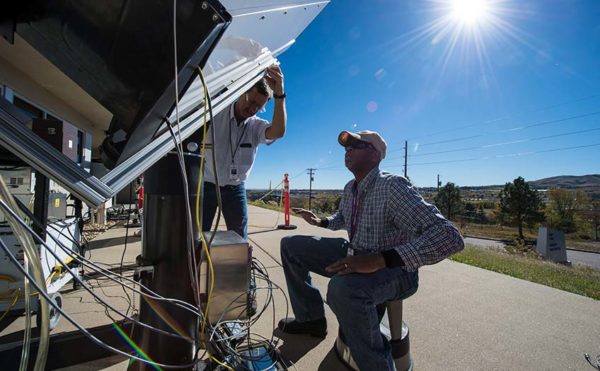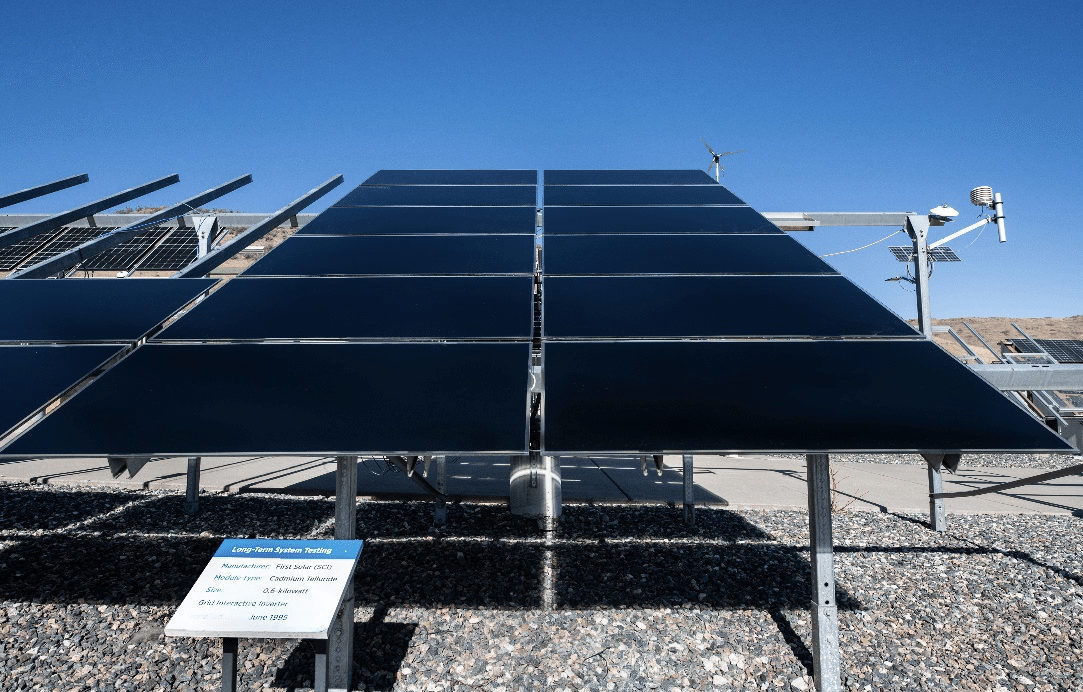It’s 1995 and Bill Clinton is president. The only discussions of global warming are in technical papers and oil company board rooms. Gangsta’s Paradise by Coolio is No.1 and Waterfalls by TLC is No. 2 on the song chart. The U.S leads the world in solar panel production with 35 MW built.
That’s the same year that cadmium telluride solar panels built by First Solar’s earlier incarnation, Solar Cells Inc., were installed at NREL’s outdoor test facility (OTF) in Golden Colorado.
Those panels are still performing, as is First Solar — unlike most of the 1995-vintage vendors that planted their panels at NREL in the previous century — such as Shell, Amoco or Arco.
NREL’s outdoor test facility (the OTF)
First Solar’s thin-film solar modules hit 25 years of continuously monitored performance testing — as part of the longest-running research project at NREL’s OTF.
While the OTF is equipped to perform accelerated testing, nothing is a match for years in the field. NREL uses multi-year outdoor testing to validate its accelerated testing. A solar module with a longer lifetime produces more value and less waste.
The nearly 40 test beds surrounding the OTF building allow researchers to chart the electrical output performance of PV modules under outdoor conditions; test the long-term performance and stability of PV modules and systems under standard and accelerated outdoor conditions; and measure the performance of hybrid systems, according to a release from NREL.
One I-V system used by the researchers to measure the electrical output performance of PV modules under outdoor conditions (and as close as possible to standard test conditions), is the Standard Outdoor Measurement System, a fixed system on which modules are placed for testing and can track the sun. NREL looks to make measurements under a clear sky, with irradiance between 950 and 1050 W/m2, and as close to 25°C as possible.
Long-term test results
First Solar’s origin story includes DOE funding for researching cadmium telluride PV technology in the early 1990s. Among the companies involved in the research was Solar Cells Inc., which later became First Solar.
Ben Kroposki, an NREL engineer who installed the initial PV modules for First Solar at the OTF, said “We always intended to keep the modules/arrays installed at the OTF as long as the technologies were relevant to get very long-term reliability data,” in a release.
The initial studies on First Solar’s panels revealed that after five years, the company’s panel degradation amounted to a relative 0.6% a year.
NREL now finds, 25 years later, that the long-term degradation of the studied modules was 0.5% a year, with an efficiency, today, of around 88% of the original panel performance.
Louis Trippel, VP of product management at First Solar, added that the lessons learned from the testing at NREL provided “incremental confidence to help support a recently announced extension” of its module power output warranty from 25 years to 30 years. First Solar’s modules are warranted at 0.5% degradation per year — but the company “guides” to 0.4%.
NREL has also worked with silicon high-efficiency solar panel builder SunPower (now Maxeon) to develop a method to calculate solar panel degradation. After eight years of energy performance data, SunPower panels were shown to degrade at a median rate of 0.2% per year. Trina Solar provides a 30-year linear warranty and a 0.5% annual degradation rate for its silicon solar panels.
But most solar firms haven’t tested their panels for the actual duration of the warranty term.
Different insides
While the solar modules under test are specified at 1995-era performance levels of 45 W output with a 6% efficiency, the dimensions of the module are the standard pre-Series 6 First Solar form-factor.
Trippel noted that the company’s current technology suite is a marked improvement over the panels tested at the OTF. The old panels did not have an edge seal and used only an EVA encapsulant, while today’s modules use a polyolefin encapsulant as well as an edge seal component. Other materials and manufacturing improvements have been made in junction box potting materials, plastics, adhesives and the solar absorber stack itself.
Nick Strevel, the company’s VP of product management, noted, “Our product encapsulation technology and materials today are far superior,” but this testing “helps us understand a legacy performance baseline and provides further confidence in the superior long-term durability and long-term degradation performance of today’s product.”
Strevel said, “Measuring degradation is hard to get to a tenth or hundredth percent — you need some time to get that level of accuracy.” It’s engineers like Dirk Jordan and the OTF staff at NREL focused on PV degradation who develop tools and techniques to make that happen.

This content is protected by copyright and may not be reused. If you want to cooperate with us and would like to reuse some of our content, please contact: editors@pv-magazine.com.








Seems like the panels will outlive most careers at a particular place.
It is also nice that someone could put panels on their roof and 30 years later they will still be producing a substantial amount of electricity. I understand because of tax reasons utility scale will probably repower around year 12 which sucks from a waste point of view. Maybe this will make it into home ground mount systems.
As you point out the significant changes that the First Solar panels have gone through, from an engineering point of view it is a mistake to assume all the changes have no effect on operating life and that all design changes extend life of the panels. Engineering history is full of “improvements” that carried unintended consequences. It might be unlikely, but it can be a misguided extrapolation.
Nice to see that the First Solar CdTe modules are so robust. When they went in, the field was littered with companies who failed because of CdTe instability. First Solar must be doing something right that the rest of the field has never matched.
The article implied that the other thin film modules have either failed or they were removed when their source went out of business. It would be nice to hear the actual facts about the CIS modules from their various sources. Even the a-Si modules might be the basis of some lessons-learned. There were also other CdTe modules – what happened to them, as well.
Thanks Ken, Good to hear from you. NREL didn’t seem keen on sharing other vendor info. I’ll follow up.
Always a pleasure to read your articles. First class.